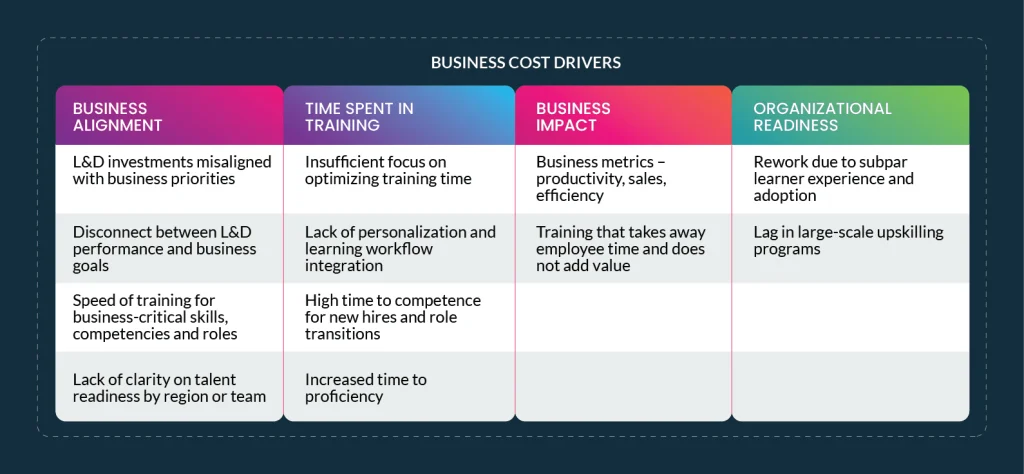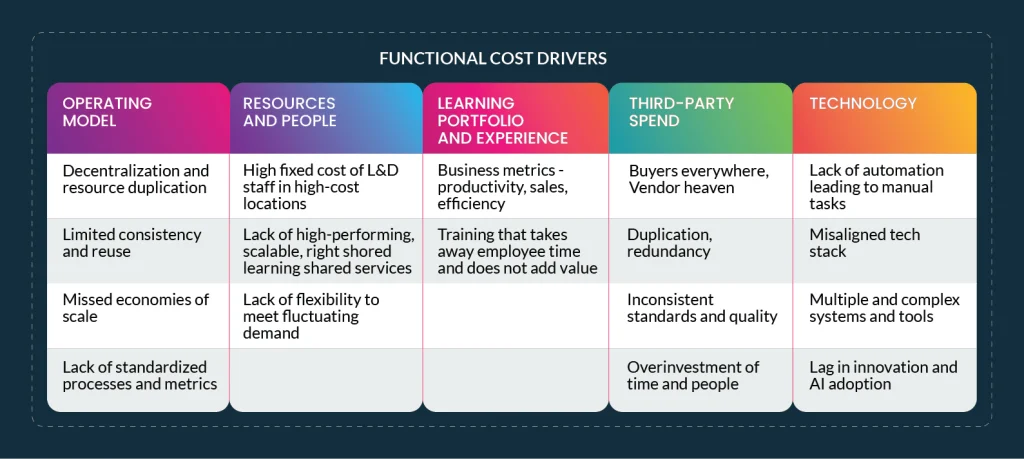
What’s Driving Up Your L&D Costs?
Hint: It’s not just inflation.
In a world where agility and skills define competitive advantage, companies are doubling down on learning. But as budgets swell and learning programs expand, many leaders are asking a tough question:
“Why are our L&D costs climbing, and what are we really getting in return?”
If this sounds familiar, you’re not alone. L&D leaders everywhere are feeling the pressure to do more with less while proving that their learning investments are actually moving the needle.
Let’s unpack some of the key reasons your L&D costs might be creeping up (often without delivering the impact you’d expect), and what to watch out for as you scale your learning and development strategy.
The Hidden Drivers of L&D Cost Overload
Not all cost drivers are created equal. Some stem from the business side, the way learning is aligned (or misaligned) with organizational goals. Others come from the functional side, the internal workings of the L&D team itself.
Let’s break down what this looks like in practice.
Business-Level Cost Drivers
If your learning and development strategy isn’t sound, your efforts could do more harm than good. Business-level cost drivers are systemic issues tied to how the organization approaches learning and can take many forms, including:
1. Lack of Alignment Between L&D and Business Strategy
When L&D operates in isolation, it often produces training that doesn’t address real business needs. The result? Programs that don’t move the needle and a steady drain on your budget.
Ask yourself:
- Are business leaders involved in learning planning?
- Do you define success in business terms, not just completion rates?
- Are investments prioritized based on workforce needs?
Without clear alignment, you risk building L&D solutions no one asked for and no one uses.
2. Fragmented Learning Functions Across Business Units
In decentralized organizations, different business units often manage their own L&D functions. This may seem efficient locally, but at scale it leads to:
- Content duplication
- Inconsistent quality
- Multiple contracts with similar vendors
Consolidating into a federated model can unlock both visibility and cost savings.
3. Unclear Business Outcomes or Metrics
Many L&D teams still measure activity (like number of courses delivered) instead of business impact (like reduced onboarding time or improved sales performance). Without outcome-based planning and tracking, it’s impossible to prioritize what truly matters and easy to overspend on what doesn’t.
4. Vendor Sprawl and Unmanaged External Spend
Multiple departments working with different providers leads to a patchwork of vendor contracts, pricing, and standards. This drives up both costs and complexity. Strategic sourcing and vendor rationalization can help you negotiate better rates and reduce the total number of suppliers.

Functional-Level Cost Drivers
The way you organize your L&D function not only impacts results but also costs. Challenges stemming from these internal operations may include:
1. Over-Reliance on Formal Learning
Instructor-led training (ILT), lengthy eLearning, and compliance-heavy formats dominate in many organizations. While sometimes necessary, these are among the most expensive ways to deliver learning, especially when adoption is low.
Incorporating informal, digital, and in-the-flow learning formats can reduce costs while boosting learner engagement.
2. Inefficient, Manual Learning Processes
Many L&D teams still rely on spreadsheets, email-based workflows, and disconnected systems. These inefficiencies lead to wasted time, duplicated effort, and high admin overhead.
Streamlining and automating L&D processes across design, delivery, and administration is key to driving operational efficiency.
3. Outdated or Overlapping Technology
When tech evolves faster than your strategy, you end up with a bloated stack: multiple authoring tools, LMSs, and analytics platforms that don’t talk to each other.
Besides licensing costs, tech complexity drains productivity. A unified learning ecosystem reduces redundancy and improves data visibility.
4. Unrationalized Learning Portfolio
Many companies lack a structured content strategy. As a result, the L&D library becomes a catch-all full of outdated, duplicated, or underused content.
A rationalized portfolio ensures:
- Content aligns with business goals
- Learners aren’t overwhelmed
- Development costs are minimized
5. Limited L&D Team Capabilities
Sometimes the hidden cost lies in skill gaps within the L&D team. If your team lacks capabilities in digital learning design, data analysis, or business consulting, it can take longer and cost more to deliver high-impact programs.
Investing in L&D capability building ensures your team can work smarter, not harder.

Why L&D Solutions Matter Now
In many organizations, the L&D function is evolving from a service provider to a strategic enabler. That’s a good thing but it comes with higher expectations.
CLOs and L&D leaders are being asked to:
- Deliver faster, more personalized learning
- Align learning with business transformation
- Reduce fixed costs and increase flexibility
- Prove ROI
Doing all this without a clear understanding of where your current spend is going and why, is like building a house without a blueprint. The result? Budget bloat, underutilized platforms, and disengaged learners.
A Real-World Example of Cost Optimization
A global life sciences leader is managing learning across a dispersed and highly regulated environment. Each region operates its own LMS processes. Vendors are fragmented. Compliance requirements like GxP add extra layers of complexity and costs are rising fast.
A closer look reveals:
- A decentralized LMS landscape with manual administration
- Inconsistent scheduling and intake workflows
- Compliance risks due to lack of validation readiness
- Multilingual training needs across 12 countries
By partnering with NIIT, the company centralized LMS operations, automated key workflows, and migrated seamlessly to SuccessFactors all while ensuring GxP validation and audit readiness.
The results? A 35% reduction in admin costs, 55% savings in cost per learner, and over $4 million saved annually, while supporting 45,000 learners at 98% SLA compliance.
It wasn’t only about saving L&D costs. It was about building a scalable, future-ready learning ecosystem.
How Does Your Learning and Development Strategy Look?
Don’t think you have to overhaul your learning and development strategy overnight. Just step back and ask yourself some important questions:
- Where is our L&D spend going today?
- Are our learning programs aligned with real business outcomes?
- Do WE know what’s working and what’s not?
- Are our systems helping US scale, or slowing US down?
If the answers aren’t clear, that’s okay. These are the kinds of challenges many organizations are facing and they’re all solvable with the right insight and approach.
How L&D Consulting and Advisory Support Can Help
Sometimes, a fresh perspective makes all the difference. Engaging with L&D consulting and advisory experts can help you:
- Get a transparent view of your current L&D landscape
- Benchmark your costs and capabilities
- Identify quick wins and long-term opportunities
- Build a learning and development strategy that’s lean and impact-driven
You don’t need to have all the answers. You just need a starting point.
Rethink the L&D Cost-Value Equation
Here’s the bottom line: Rising L&D costs are often the result of well-meaning growth without strategic guardrails.
But by taking a step back and looking at the bigger picture, you can uncover opportunities to simplify, align, and elevate your learning function while keeping budgets in check.
It’s not about spending less. It’s about spending smarter.
Explore more about a strategic approach to L&D cost optimization.